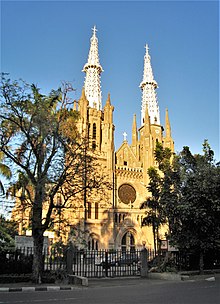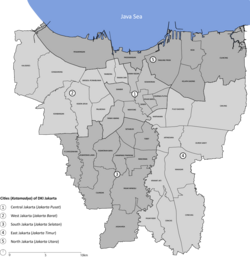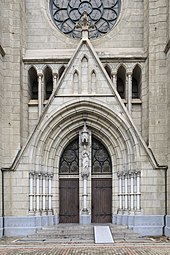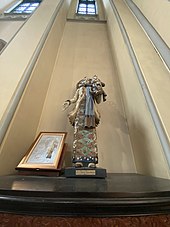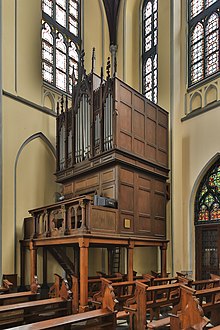
The Sacred Heart Cathedral is a Catholic church in Sarajevo; commonly referred as the Sarajevo Cathedral, it is the largest cathedral in Bosnia and Herzegovina. It is the seat of the Archbishop of Vrhbosna, currently Tomo Vukšić, and center of Catholic worship in the city. The cathedral is located in the city's Old Town district.

Istiqlal Mosque in Jakarta, Indonesia is the largest mosque in Southeast Asia and the ninth largest mosque in the world in terms of worshipper capacity. Built to commemorate Indonesian independence, this national mosque of Indonesia was named "Istiqlal", an Arabic word for "independence". The mosque was opened to the public on 22 February 1978. Within Jakarta, the mosque is positioned next to Merdeka Square and the Jakarta Cathedral (Catholic) and also of the Immanuel Church (Reformed).

The Metropolitan Cathedral of Our Lady Assumption and Saint Paul, also known as the See Cathedral, is the cathedral of the Roman Catholic Archdiocese of São Paulo, Brazil. Its current and seventh metropolitan archbishop is Dom Odilo Pedro Cardinal Scherer, appointed by Pope Benedict XVI on March 21, 2007, and installed on April 29 of the same year. The existing cathedral's construction, in a Gothic revival style, began in 1913 and ended four decades later. It was ready for its dedication on the 400th anniversary of the foundation of the then humble villa of São Paulo by Chief or Cacique Tibiriçá and the Jesuit priests Manuel da Nóbrega and José de Anchieta. Despite its Renaissance-style dome, the São Paulo Metropolitan Cathedral is considered by some to be the fourth largest neo-Gothic cathedral in the world.

The Cathedral of St. John the Baptist is the mother church of the Roman Catholic Diocese of Charleston, located in Charleston, South Carolina. Designed by Brooklyn architect Patrick Keely in the Gothic Revival style, it opened in 1907. The Most Reverend Jacques E. Fabre, the fourteenth Bishop of Charleston, was ordained and installed on May 13, 2022

Eduard Cuypers was a Dutch architect. He worked in Amsterdam and the Dutch East Indies.

The Church of St Peter and St Paul, the co-cathedral of the Roman Catholic Archdiocese of Đakovo-Osijek, is a neo-Gothic sacral structure located in Osijek, Croatia. The multi-tiered 90-metre spire is one of the city's landmarks. The church was built in 1898 on the initiative of the Bishop of Đakovo Josip Juraj Strossmayer.

The Co-Cathedral of Saint Nicholas in Prešov is one of the oldest and most important churches in Slovakia. The external dimensions of the cathedral are 54.7m in length, 34.45m in width. The indoor nave is 16 m tall and tower reaches a height of 71 meters. The temple's design takes inspiration from the Late Gothic hall churches with three naves.

The Protestant Church in Western Indonesia Immanuel Semarang, better known as Blenduk Church, is a Protestant church in Semarang, Central Java, Indonesia. Built in 1753, it is the oldest church in the province.
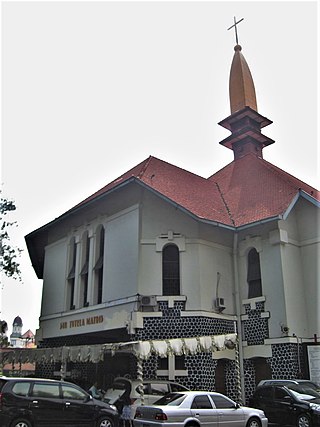
The Cathedral of the Virgin Mary, Queen of the Holy Rosary, also known as the Holy Rosary Cathedral or Randusari Cathedral is a Roman Catholic cathedral and the seat of the Archdiocese of Semarang. Finished in 1927 at Randusari, Semarang, Indonesia, it became a parish church in 1930 and a cathedral in 1940, when Albertus Soegijapranata was made the first archbishop of Semarang.

St. Joseph's Church, also known as Gedangan Church, is a Catholic church in Semarang, Indonesia, the first such church in the city. Administratively, it is part of the St. Joseph's Parish in the Archdiocese of Semarang.

Chur Cathedral, otherwise known as the Cathedral of the Assumption of Mary, is the Catholic cathedral of the diocese of Chur in Switzerland. The episcopal palace of the bishop of Chur is beside the church. The cathedral claims the relics of St Lucius of Britain, said to have been martyred nearby in the late 2nd century. During the Swiss Reformation, the Catholic population of the city were confined to a ghetto enclosed around the bishop's court beside the cathedral. It is a Swiss heritage site of national significance.

Medan Cathedral is a Roman Catholic Cathedral in Medan, Indonesia. The current cathedral was inaugurated in 1928. It is one of the Dutch colonial buildings in Medan.

The St. Peter in Chains Church is a church in Neo-Gothic style with a rich Baroque interior located at the Market Square in Beringen, Belgium. It is the parish church of Beringen centre and the decanal church of the deanery of Beringen. The chancel, nave and transept are protected since 1949 and the neo-Gothic parts since 1993.

The Holy Family Cathedral is a religious building of the Catholic Church in Banjarmasin in the province of South Kalimantan, Indonesia. It was designed by architect Roestenhurg in a neo-Gothic style.

Johannes Martinus (Han) Groenewegen was a Dutch architect who was active in the Netherlands and the Dutch East Indies, and subsequently, Indonesia from the 1920s to the 1960s.
The St. Mary Assumpta Cathedral, also called Tanjung Selor Cathedral, is a Catholic church located in the city of Tanjung Selor, a district in the regency of Bulungan in the province of Kalimantan of the North to the northeast of the island of Borneo in Indonesia.
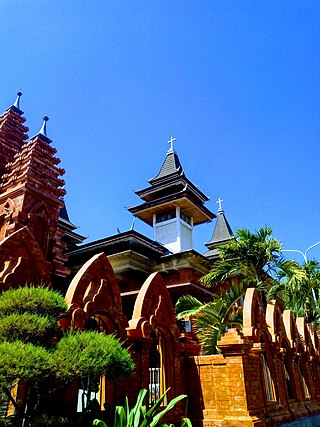
The Holy Spirit Cathedral also called Denpasar Cathedral is a religious building affiliated with the Catholic Church located in the city of Denpasar on the island of Bali in the south of the Asian country of Indonesia.
Tunnel of Friendship, or Tunnel of Silaturahmi is an underground tunnel connecting the interior of Istiqlal Mosque and St. Mary of the Assumption Cathedral in Jakarta, Indonesia.The tunnel was constructed as part of the plan to renovate the mosque, and the construction was started on 15 December 2020. It took around 10 months to be finished and was finished in September 2021.
